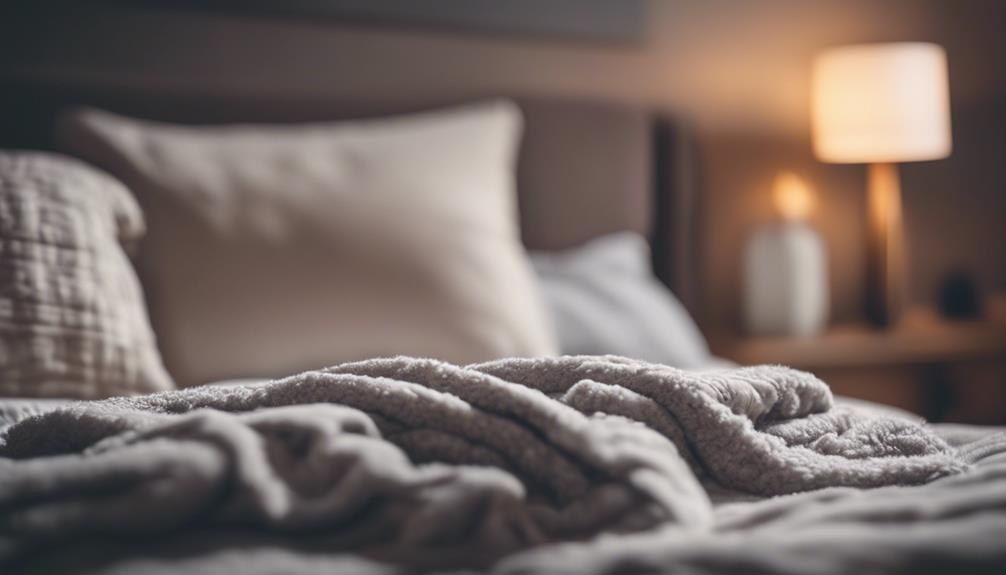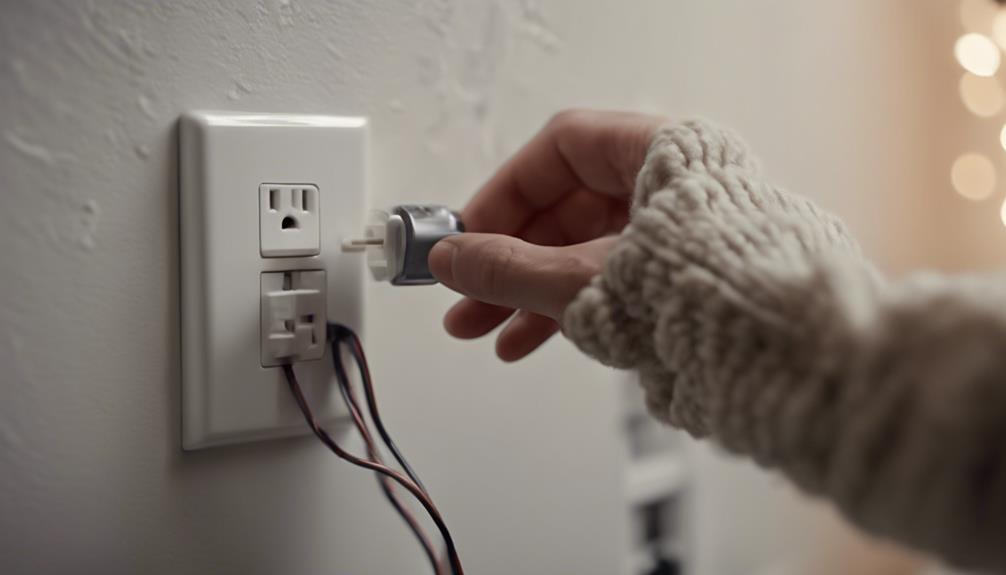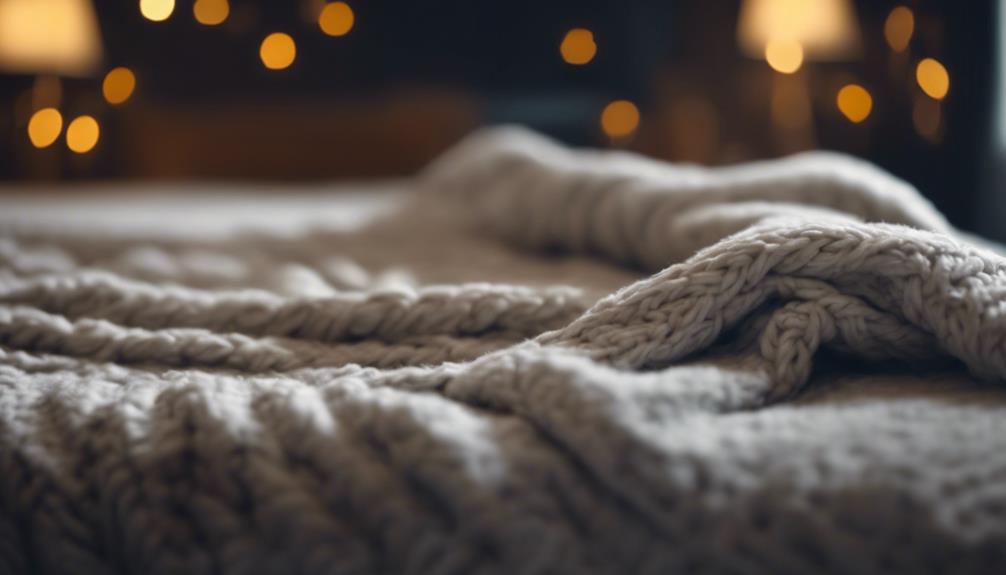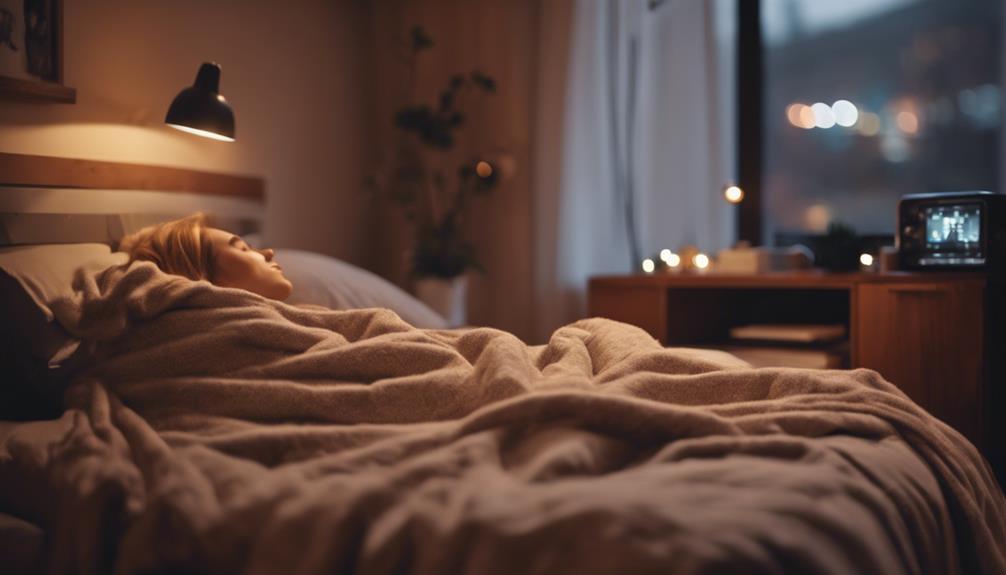Sleeping with an electric throw blanket can be done safely by following certain guidelines. Look for safety features such as auto-shutoff. Make sure to turn it off before bedtime, control the temperature, and avoid leaving it on overnight. Check for any damage or exposed wires. Set the temperature to a moderate level and refrain from folding it. Plug it directly into a wall outlet for safety. Follow the care instructions for washing and storing properly. Safety should be a top priority to avoid accidents and keep the blanket in good condition. The following steps will offer more information on how to safely enjoy the warmth and comfort provided by an electric throw blanket.
Key Takeaways
- Use with caution, avoid all-night use.
- Check for safety features like auto-shutoff.
- Follow manufacturer's guidelines for safe usage.
- Place on top of bedding, not under.
- Ensure blanket is in good condition before use.
Safety Guidelines for Sleeping With Electric Throw

When using an electric throw blanket for sleeping, always check for safety features like an auto-shutoff to prevent overheating. This feature is vital in maintaining a safe sleeping environment as it prevents the blanket from reaching dangerously high temperatures.
Electric blankets can enhance the comfort of your sleep by providing warmth, but it's important to prioritize safety guidelines to prevent any accidents. Before using the electric blanket, make sure it's in good condition without any tears or exposed wires that could pose a risk.
Additionally, avoid leaving the blanket on overnight to reduce the chances of overheating. Following the manufacturer's instructions on proper use and care of the electric throw blanket is crucial for maintaining safety standards.
Consider preheating the bed with the electric throw blanket before sleeping and remember to turn it off before getting into bed for a comfortable and safe experience. By adhering to these safety guidelines, you can enjoy the benefits of using an electric blanket for a cozy night's sleep.
Proper Usage of Electric Throw Blankets

When using electric throw blankets, it's important to follow safe sleeping practices.
Always remember to turn off the blanket before going to bed to prevent overheating.
Controlling the temperature and avoiding leaving the blanket on overnight are key tips for ensuring a safe and comfortable sleep experience.
Safe Sleeping Practices
To use electric throw blankets safely, it's advisable to preheat your bed before sleeping to enjoy warmth without needing continuous use throughout the night. Turning off the electric blanket before getting into bed helps maintain a comfortable sleeping temperature.
Placing the heated blanket on top of the covers can help trap heat in the mattress, providing warmth even after it's turned off. Proper usage of electric blankets can help prevent risks associated with interfering with body temperatures during sleep.
Temperature Control Tips
Properly setting the electric throw blanket to a comfortable temperature is essential for safe and cozy sleep. When using a heated blanket, it's important to adjust the settings to prevent overheating. Consider your personal preference and the room temperature when choosing the heat level. Utilize the timer function, if available, to automatically shut off the blanket after a set time to avoid prolonged use. It's best not to sleep with the electric throw blanket on all night to prevent overheating and guarantee safety. To create a warm bed for bedtime, preheat it with the blanket and then turn it off before settling in for a restful sleep.
| Temperature Control Tips | ||
|---|---|---|
| Adjust settings for comfort | Use timer function | Avoid overheating |
Ensuring Electric Blanket Condition Before Use

Before snuggling up with an electric throw blanket, it's important to inspect the plug and cord for any signs of wear or damage.
A quick check can help guarantee that the blanket is safe for use and prevent any potential hazards.
Taking this simple step can go a long way in maintaining the condition and safety of your electric blanket.
Check Plug and Cord
Before using an electric blanket, make sure the plug and cord are free of any visible damage or fraying to prevent safety hazards. Inspecting the electrical components is vital in ensuring there are no exposed wires or signs of overheating.
It's important to confirm that the plug fits securely into the wall outlet to prevent loose connections or potential electrical hazards. If any wear and tear is noticed on the plug or cord, it's advisable to refrain from using the electric throw blanket to mitigate safety risks.
Regularly checking the condition of the plug and cord is essential for maintaining a safe sleeping environment with an electric throw blanket.
Inspect for Damage
Upon receiving an electric throw blanket, the first step is to thoroughly examine it for any tears, exposed wires, or scorch marks to guarantee its safety before use. Damaged electric blankets can pose serious safety risks, including fires and electric shocks. It is crucial to discard any electric blanket that shows signs of damage to prevent accidents. Proper inspection before use can ensure the safe operation of your electric throw blanket. Regularly checking for wear and tear is essential for maintaining the safety of your electric blanket.
| Inspect for Damage | ||
|---|---|---|
| Tears | Exposed Wires | Scorch Marks |
| Fire Risk | Electric Shocks Risk | Safety Assurance |
Importance of Setting Temperature Correctly

Setting the temperature correctly on an electric throw blanket is vital for ensuring comfort and safety during use. When using an electric blanket, heat is regulated to keep the body warm, especially during colder nights. It helps prevent the core body temperature from dropping too low, which can happen as you fall asleep.
If the temperature is set too high, it can lead to overheating, causing discomfort, sweating, and disruptions in sleep. To maintain a cozy and safe environment, it's essential to adjust the temperature to a moderate level that suits personal preferences and room conditions. By following the manufacturer's recommendations for temperature settings, you can guarantee the effective and secure use of the electric throw blanket.
Keeping the heat at a comfortable level not only enhances safety but also promotes better sleep quality, allowing you to enjoy the benefits of using an electric throw blanket without any risks of overheating.
Avoiding Overheating With Electric Throws

When using electric throw blankets, it's important to monitor the temperature to prevent overheating. Be sure to follow safety guidelines provided by the manufacturer and avoid prolonged use while sleeping.
Temperature Control Tips
How can we guarantee that electric throw blankets don't overheat while providing warmth during use? To maintain a comfortable temperature and prevent overheating, consider the following tips:
- Adjust the temperature controls to a moderate setting suitable for your comfort.
- Utilize features like auto-shutoff to safeguard against excessive heat accumulation.
- Regularly check the blanket's temperature to ensure it remains at a safe level.
- Avoid folding or bunching the blanket, as this can lead to localized overheating.
- Follow manufacturer guidelines for proper usage and temperature management to prevent discomfort and potential health risks.
Safety Precautions Reminder
To prevent the risk of overheating with electric throw blankets, it is essential to follow recommended safety precautions. Overheating risks can be mitigated by being mindful of the body's natural temperature regulation. Continuous use of an electric blanket while sleeping can disrupt this regulation, leading to potential health issues. One way to avoid overheating is by preheating the bed with the electric blanket and then turning it off before getting in. Additionally, utilizing features like timers and auto-shutoff can help in preventing overheating incidents. It is important to prioritize safety when using electric blankets to guarantee a comfortable and risk-free experience.
| Safety Precautions | Description |
|---|---|
| Turn off before sleep | Prevents prolonged exposure to heat |
| Preheat then turn off | Warms bed without continuous use |
| Use timers | Helps regulate heating duration |
| Check auto-shutoff | Ensures safety in case of overheating |
Plugging Electric Blanket Into Wall Outlet

Plugging our electric blanket directly into a wall outlet is recommended to minimize the risk of overheating and guarantee safe usage. This practice is advised by manufacturers to prevent safety hazards associated with using extension cords. Here are some reasons why plugging the electric blanket into a wall outlet is important:
- Reduced Risk of Overheating: Directly plugging the blanket into the wall outlet prevents overheating issues that may arise with the use of extension cords.
- Safety Hazards: Using extension cords with electric blankets can pose safety risks due to potential overheating, leading to electrical hazards.
- Manufacturer's Recommendations: Manufacturers suggest plugging the electric blanket directly into a wall outlet for maximum safety and performance.
- Preventing Electrical Issues: Avoiding extension cords ensures the safe operation of the electric blanket and minimizes the chances of electrical problems.
- Maintaining Safety Standards: Following the manufacturer's instructions and plugging the electric blanket into a wall outlet helps uphold safety standards and ensures safe usage of the blanket.
Manufacturer's Care Instructions for Electric Throws

When caring for your electric throw blanket, following the manufacturer's instructions is essential to guarantee its safe and proper use.
Start by checking the care label to determine if your electric throw blanket is machine washable or if it requires spot cleaning only. For machine washable blankets, use a gentle cycle with mild detergent to avoid damaging the heating elements. When cleaning, steer clear of harsh chemicals and bleach to maintain the integrity of the blanket.
After washing, make sure the electric throw is thoroughly air-dried before storing to prevent any moisture-related issues.
When storing your electric throw blanket, keep it in a cool, dry place away from direct sunlight and extreme temperatures to prolong its lifespan.
Safe Practices for Electric Throw Usage

Implementing proper safety practices when using electric throw blankets is vital for preventing potential risks and ensuring comfortable warmth during sleep. When it comes to safe practices for electric throw usage, it's important to follow the manufacturer's guidelines meticulously to avoid any mishaps. Here are some key points to remember:
- Avoid using the electric blanket all night: Continuous use can interfere with the body's ability to regulate temperature properly.
- Be cautious with neuropathy: Neuropathy causes pain, and the intense heat from an electric blanket can exacerbate this condition.
- Check for safety features: Make sure your electric throw blanket has auto-shutoff functionality to reduce risks while sleeping.
- Use it on top of your regular bedding: Placing the electric throw blanket over your regular bedding helps with heat distribution and prevents burns.
- Preheat your bed: Consider preheating your bed with the electric blanket before getting in to maintain a comfortable sleeping temperature.
Cozy and Safe Sleeping Tips

To guarantee a cozy and safe sleeping experience with an electric throw blanket, remember to follow recommended safety precautions and consider alternative options for personalized warmth. Electric blankets can provide a toasty preheated bed without the need for continuous use overnight. However, it's essential to turn off the electric blanket before getting into bed to avoid prolonged exposure to heat, reducing the risk of overheating. Look for features like auto-shutoff on electric blankets to enhance safety measures further.
Additionally, placing the electric throw blanket on top of your covers can help trap heat in the mattress, offering added warmth without direct contact with your body.
For those seeking alternatives, hot water bottles or weighted blankets are excellent options for localized warmth and a safer sleep environment. By incorporating these precautions and exploring other warming methods, you can enjoy a cozy night's rest with your electric blanket while prioritizing safety and comfort.
Benefits of Using Electric Throw Safely

Using an electric throw blanket safely can provide both warmth and peace of mind during colder nights. When we use an electric blanket, we must be cautious to prevent accidents and potential harm. Here are some benefits of using electric throws responsibly:
- Preventing nerve damage: Sleeping with an electric blanket can lead to excessive heat exposure, potentially causing nerve damage over time.
- Avoiding interference with sleep: Leaving them on overnight might interfere with an individual's sleep patterns, leading to disrupted rest.
- Reducing risks of medical conditions: Prolonged use can increase the risk of developing skin burns or other medical issues.
- Ensuring safety: Using an electric throw blanket for its intended purpose and following safety guidelines can help prevent accidents.
- Peace of mind: Knowing that you're using your electric throw safely can bring peace of mind, allowing you to enjoy its warmth without worry.
Frequently Asked Questions
Can You Sleep With an Electric Throw Blanket?
Yes, you can sleep with an electric throw blanket, but it's not ideal for overnight use. Extended periods of sleeping with it can lead to overheating and discomfort, disrupting your body's natural temperature regulation.
It's safer to preheat your bed with the electric throw blanket before sleeping and then turning it off for the night. This method can help you stay cozy without risking overheating or discomfort during sleep.
How Safe Are Electric Throw Blankets?
Electric throw blankets are essential for safe usage during sleep. They've safety features like auto-shutoff to prevent overheating. These blankets offer localized warmth and can preheat the bed.
It's advisable to avoid sleeping directly on them to prevent discomfort or overheating. Regular maintenance and inspection are important for safe usage during sleep.
Are Heated Blankets Safe for Dogs?
Heated blankets can be safe for dogs when used correctly. It's important to follow the manufacturer's guidelines and prevent any chewing or damage to the blanket.
Keeping an eye on your dog's behavior around the heated blanket is vital to make sure they don't get too hot. Opt for lower heat settings when your furry friend is using the blanket.
If you have any doubts, consulting your vet can provide tailored advice for your dog's safety and comfort.
Are Electric Blankets Safe for Heart Patients?
Electric blankets can pose risks for heart patients due to potential overheating and increased body temperature. Overheating can strain the heart and worsen existing cardiovascular conditions.
It's important for heart patients to consult their healthcare provider before using electric blankets to assess safety risks. Monitoring body temperature and avoiding excessive heat exposure is essential for safe use.
Careful consideration of sleep environment temperature is crucial for maintaining heart health.
Conclusion
To sum up, while sleeping on an electric throw blanket can be safe when used properly, it's essential to follow safety guidelines and manufacturer's instructions to avoid any potential risks.
By ensuring the blanket is in good condition, setting the temperature correctly, and practicing safe usage habits, you can enjoy a cozy and comfortable night's sleep.
Remember, taking precautions is key to a restful night's sleep with an electric throw blanket.
Stay tuned for more tips on staying safe and cozy.










